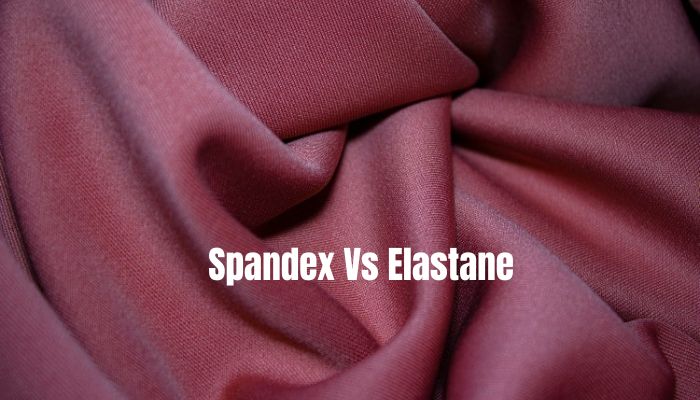Both elastane and spandex are popular for use in athletic apparel because of their ability to move with the body. Although the two terms are frequently used interchangeably, they actually refer to different materials. This article compares elastane with spandex in terms of its stretchiness, weight, comfort, and durability so that you may make an informed choice. We will explore “Spandex Vs Elastane comparison & Amp Difference- which is better?”, in this post.
Spandex Vs Elastane Comparison
The detailed comparison between Spandex Vs Elastane is given below-
Stretchy textiles like spandex and elastane are frequently used for sportswear and clothing for the gym. The chemical makeup of spandex and elastane is the primary distinction between the two. The synthetic polymer polyurethane is used to create Spandex, while the synthetic fiber polyester is the basis for elastane. Although both of these fibers are extremely stretchy, spandex has much more elongation, stretching up to 500% of its original length before breaking.
Furthermore, spandex has great recuperative abilities, even after repeated stretching. This makes it a great option for creating bodysuits, swimwear, and dancewear, among other forms of form-fitting apparel. Elastane, on the other hand, offers a similar level of comfort and stretchability without the durability or elasticity of spandex. It’s ideal for use in both lingerie and sportswear because of its strong colorfastness, resistance to creases, and form retention abilities.
The cost-effectiveness of these two fibers is another key distinction between them. Spandex is more expensive than elastane because to its higher quality and performance, but it lasts far longer because of its robust resilience. Elastane, on the other hand, is less expensive, thus it appeals to thrifty buyers who are looking for stretchy, flexible, and inexpensive things.
Depending on the specifics of the task at hand, both natural and synthetic fibers provide their own set of benefits and downsides. Elastane is more cost-effective than Spandex and has good moisture absorption and cooling capabilities, making it appropriate for summer clothes or sportswear. Spandex, on the other hand, has unsurpassed flexibility and superb form fitting skills.
Spandex Vs Elastane Difference
The key difference between Spandex Vs Elastane is given below-
- Spandex and elastane are two types of synthetic fabrics that use fibers derived from polyurethane.
- Spandex is more expensive than elastane yet has more stretch than it does.
- Elastane is not as stretchy as spandex, but it lasts longer, doesn’t fade, and is unaffected by fire or chemicals.
- In addition, the texture of spandex is smoother than that of elastane.
- After being stretched, elastane returns to its original shape more quickly than spandex.
- Spandex is great for sportswear because of its excellent stretchability, but elastane is better for intimate apparel like bras, swimwear, and lingerie since it maintains its shape over time.
Spandex Vs Elastane Pros and Cons
The Pros and Cons of Spandex Vs Elastane is given below-
- Elastane, formerly branded as Lycra, is a kind of polyurethane with a chemical name similar to that of Spandex (1959 invention by DuPont).
- Spandex is more robust, elastic, and long-lasting than its elastane counterpart. When compared to elastane, it provides more flexibility.
- When stretched beyond its limit, elastane quickly loses its original shape and has a lower stretch resistance than spandex fiber.
- Compared to elastane, Spandex fibers have a higher sheen and a smoother texture, making them more visually appealing when worn.
- Elastane snaps back into shape quickly after being stretched, but spandex takes several seconds.
- Spandex is typically more expensive than elastane because of its numerous desirable features (such as its strength, durability, pleasant fit, and high elasticity).
Spandex Vs Elastane- Which is better and why?
Elastane is better than spandex in many ways. Because it is stronger and less likely to degrade in the presence of chemicals, it has a wider range of potential uses than spandex. Since it recovers its previous size and shape after being stretched, elastane is also very easy to wash and maintain. When stretched or laundered, Spandex may not recover its original shape as well as other materials. Elastane is great for sportswear and other activewear because of its flexibility, resilience, and superb moisture-wicking qualities.
FAQs
Q: What is the difference between spandex and elastane?
The main difference between spandex and elastane is that spandex is made from polyurethane and elastane is a polyester-polyurethane blend. The main distinction between spandex and elastane is that the former is far more elastic and stretchy.
Q: Is spandex or elastane better for clothing?
Sportswear that clings to the body, like tights and leggings, can benefit from the Spandex’s enhanced mobility and durability. Elastane is most often used in swimsuits and denim shorts because of its durability and stretch.
Q: Is elastane the same as lycra?
The Lycra brand name refers to a specific type of flexible synthetic fabric that is manufactured by the same company that produces spandex and elastane. Unlike spandex and elastane, which are composed of a blend of polyester and polyurethane, Lycra is created from a single substance: polychloroprene rubber (commonly known as neoprene rubber).
Q: Is there an ethical alternative to spandex or elastane?
A: Yes! Bamboo viscose fabric is a popular plant-based alternative to synthetic fabrics because to its durability, flexibility, and breathability, all of which are shared with synthetic materials but without the latter’s environmental drawbacks.
I hope you like reading on comparison and difference between Spandex Vs Elastane.

